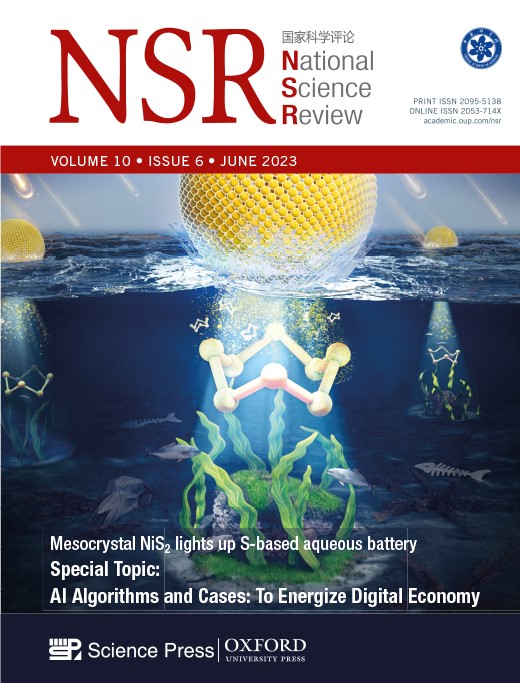Chemical and engineering bases for green H2O2 production and related oxidation and ammoximation of olefins and analogues
IF 16.3
1区 综合性期刊
Q1 MULTIDISCIPLINARY SCIENCES
引用次数: 0
Abstract
Plastics, fibers, and rubber are three mainstream synthetic materials that are essential to our daily life and contribute significantly to the quality of our life. The production of the monomers of these synthetic polymers usually involves oxidation or ammoximation reactions of olefins and analogues. However, the utilization of the C, O, and N atoms in current industrial processes is less than 80%, which represents the most environmentally polluting processes for the production of basic chemicals. Through innovation and integration of catalytic materials, new reaction pathways, and reaction engineering, Research Institute of Petroleum Processing, Sinopec Co., Ltd. (RIPP) and its collaborators have developed unique H2O2-centered oxidation/ammoximation technologies of olefins and analogues, which has formed a ¥500 billion emerging industry and driven trillions of downstream industries. The chemical and engineering bases of the production technologies mainly involve the integration of slurry-bed reactors and microsphere catalysts to enhance H2O2 production, H2O2 propylene/chloropropylene epoxidation for the production of propylene oxide (PO)/epichlorohydrin (ECH), and integration of H2O2 cyclohexanone ammoximation and membrane separation to innovate the caprolactam production process. This review briefly summarizes the whole process from the acquisition of scientific knowledge to the formation of an industrial production technology by RIPP. Moreover, the scientific frontiers of H2O2 production and related oxidation/ammoximation processes of olefins and analogues are reviewed, and new technological growth points are envisaged, aiming at keeping China as one of the leaders in the development of the science and technologies in H2O2 production and utilization.绿色 H2O2 生产以及烯烃和类似物的相关氧化和胺氧化的化学和工程基础
塑料、纤维和橡胶是我们日常生活中不可或缺的三种主流合成材料,它们对提高我们的生活质量做出了重大贡献。这些合成聚合物单体的生产通常涉及烯烃和类似物的氧化或氨氧化反应。然而,在目前的工业生产过程中,C、O 和 N 原子的利用率不到 80%,是对环境污染最大的基础化学品生产过程。通过对催化材料、新反应途径和反应工程的创新和整合,中国石化股份有限公司石油加工研究院(RIPP)及其合作者开发出了一种新的催化技术。(中石化石油加工研究院(RIPP)及其合作者开发了独特的以 H2O2 为中心的烯烃及类似物氧化/氨氧化技术,形成了 5000 亿日元的新兴产业,并带动了数万亿的下游产业。该生产技术的化学和工程基础主要涉及整合淤浆床反应器和微球催化剂以提高 H2O2 产量、H2O2 丙烯/氯丙烯环氧化以生产环氧丙烷 (PO)/ 环氧氯丙烷 (ECH),以及整合 H2O2 环己酮胺氧化和膜分离以创新己内酰胺生产工艺。本综述简要总结了 RIPP 从获取科学知识到形成工业生产技术的整个过程。此外,还回顾了 H2O2 生产和烯烃及类似物的相关氧化/氨氧化过程的科学前沿,并展望了新的技术增长点,旨在使中国在 H2O2 生产和利用的科学和技术发展方面保持领先地位。
本文章由计算机程序翻译,如有差异,请以英文原文为准。
求助全文
约1分钟内获得全文
求助全文
来源期刊

National Science Review
MULTIDISCIPLINARY SCIENCES-
CiteScore
24.10
自引率
1.90%
发文量
249
审稿时长
13 weeks
期刊介绍:
National Science Review (NSR; ISSN abbreviation: Natl. Sci. Rev.) is an English-language peer-reviewed multidisciplinary open-access scientific journal published by Oxford University Press under the auspices of the Chinese Academy of Sciences.According to Journal Citation Reports, its 2021 impact factor was 23.178.
National Science Review publishes both review articles and perspectives as well as original research in the form of brief communications and research articles.
 求助内容:
求助内容: 应助结果提醒方式:
应助结果提醒方式:


